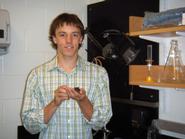
Before researchers can develop treatment for Type II diabetes, they must improve their understanding of the disease's biological progression. So far, it is clear that diabetic mice often exhibit osmotic red blood cell fragility, meaning that their red blood cells are more likely to burst than normal cells in aqueous solutions. Osmotic red blood cell fragility can cause diseases such as retinopathy, a disease of the retina that results in blindness. In an effort to lay the groundwork for diabetic medical developments, Sven Oman '10 (Watertown, N.Y.) is investigating the progression of red blood cell fragility in diabetic mice with Assistant Professor of Chemistry Nicole Snyder and Professor of Biology David Gapp.
Part of Oman's project involves exploring different factors that may contribute to red blood cell fragility. To examine potential causes of red blood cell fragility, Oman has been collecting blood samples from mice with the help of Animal Care Technician Sally Corney. Inspecting the samples for two putative sources of diabetes, spherocytes (sphere-shaped red blood cells) and glycosylated hemoglobin (different sugars linked to hemoglobin), Oman has begun to determine the osmotic fragility, blood glucose, and weight of diabetic mice over their life span.
In addition, Oman is synthesizing three azido-sugars (N-acetylmannosamine, N-acetylgalactosamine, and N-acetylglucosamine) that will be fed to the diabetic mice in order to study their glycosylation patterns (i.e., an enzymatic process that links sugars to proteins). Azido-sugars are metabolized by cells and can be detected on the cell surface with florescent probes. Detecting the kinds of glycosylated hemoglobin proteins that are present in diabetic red blood cells could have practical implications for later therapeutic developments.
Oman's previous coursework with Snyder and Gapp sparked his interest in researching red blood cell fragility in diabetic mice this summer. Oman, a neuroscience major, says that he enjoyed working with Snyder and Gapp in class and their lab curriculum. Gapp even introduced Oman to the diabetic mouse model as part of his introductory biology course. Outside the laboratory, Oman plays varsity soccer for Hamilton and enjoys swimming and cycling. He also coaches youth soccer during the summer and volunteers at the Samaritan Medical Center in Watertown.
-- by Stephanie Anglin '10
Part of Oman's project involves exploring different factors that may contribute to red blood cell fragility. To examine potential causes of red blood cell fragility, Oman has been collecting blood samples from mice with the help of Animal Care Technician Sally Corney. Inspecting the samples for two putative sources of diabetes, spherocytes (sphere-shaped red blood cells) and glycosylated hemoglobin (different sugars linked to hemoglobin), Oman has begun to determine the osmotic fragility, blood glucose, and weight of diabetic mice over their life span.
In addition, Oman is synthesizing three azido-sugars (N-acetylmannosamine, N-acetylgalactosamine, and N-acetylglucosamine) that will be fed to the diabetic mice in order to study their glycosylation patterns (i.e., an enzymatic process that links sugars to proteins). Azido-sugars are metabolized by cells and can be detected on the cell surface with florescent probes. Detecting the kinds of glycosylated hemoglobin proteins that are present in diabetic red blood cells could have practical implications for later therapeutic developments.
Oman's previous coursework with Snyder and Gapp sparked his interest in researching red blood cell fragility in diabetic mice this summer. Oman, a neuroscience major, says that he enjoyed working with Snyder and Gapp in class and their lab curriculum. Gapp even introduced Oman to the diabetic mouse model as part of his introductory biology course. Outside the laboratory, Oman plays varsity soccer for Hamilton and enjoys swimming and cycling. He also coaches youth soccer during the summer and volunteers at the Samaritan Medical Center in Watertown.
-- by Stephanie Anglin '10
Posted August 5, 2008
